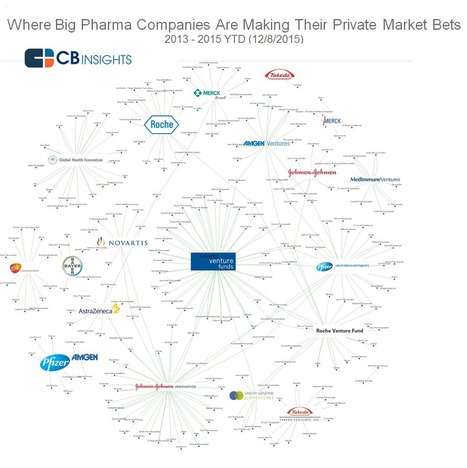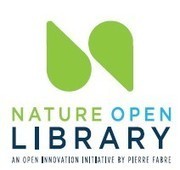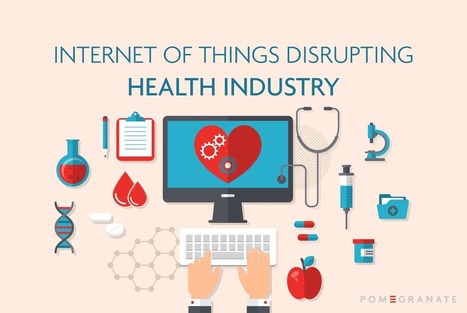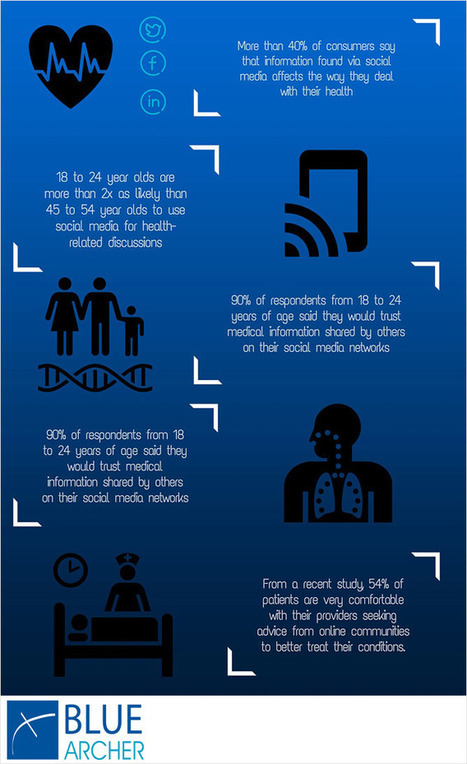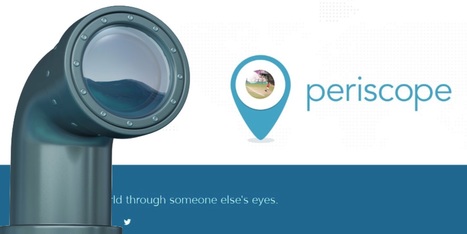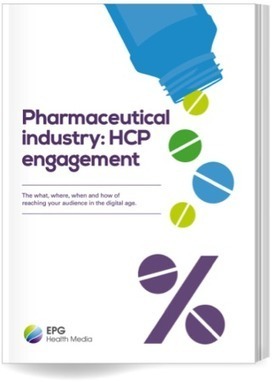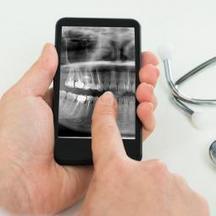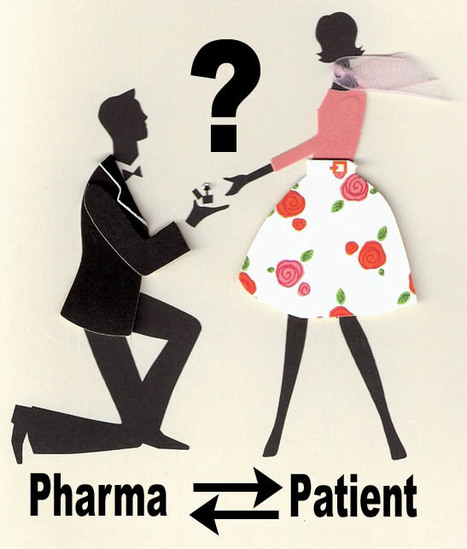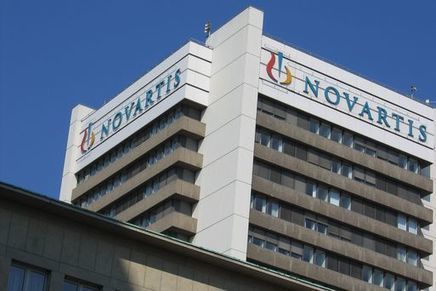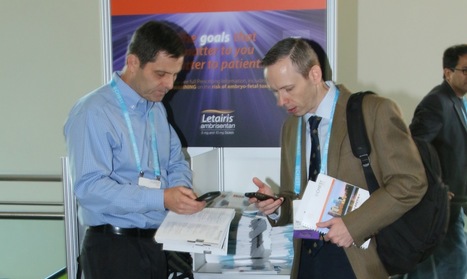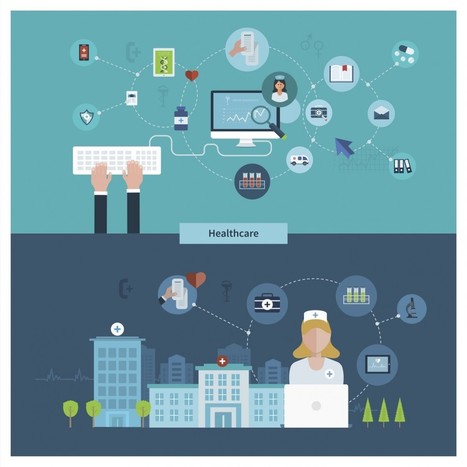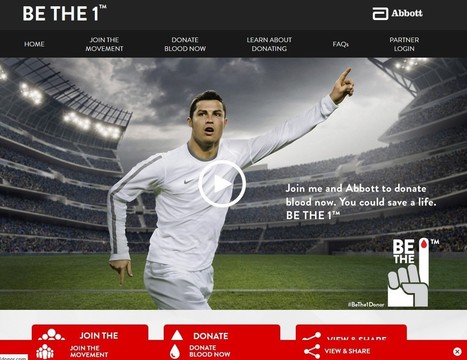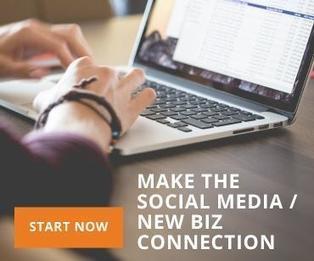 Your new post is loading...
 Your new post is loading...

|
Scooped by
Rémy TESTON
January 25, 2016 1:37 AM
|
Santé :
A quels enjeux devront répondre les thérapies de demain ?
C’est un vrai défi à la fois pour les médecins et pour les... Articles liés Pharmacie, Sanofi, Santé, Google - L'information de l'industrie

|
Rescooped by
Rémy TESTON
from Social Media and Healthcare
January 20, 2016 2:35 AM
|
Pharma companies are coming around on social media, however slowly. But how many are actually listening to what their patients say on social media platforms--and doing something with the feedback they get? IMS Health's Siva Nadarajah According to Siva Nadarajah, IMS Health's general manager of big data and compliance, too few. Only about 8% of 9% of all global brands--not companies--are engaging with patients, he said at a discussion hosted byMedical Marketing & Media. About 50% of them are monitoring patients' mentions, but 42% are doing nothing about it. And 40% aren't listening at all. Why are pharma brand managers so hesitant to listen up? Some say they "don't know what actions they could take with the data," Nadarajah said. Others do know, but they don't have the engagement channels in place to help them take the next step. Some of them fall back on regulations, saying "'I don't want to deal with adverse events. It's a burden,'" he pointed out. The way Michele Bennett, senior director of data science and analysis at Thomson Reuters, sees it, social media also represents an uncomfortable change for pharma. The industry is "used to being in control, driving the message, driving how they want their products to be perceived, within label. Social media takes the message over. You get no control," she said. But whatever the reason for turning away, it's the wrong move, experts participating in the discussion agreed. While in the past, social listening may have been "something that was done on the side," these days, "it's not something you can ignore, not a vocal minority," Nadarajah said. Tim Armand, the cofounder and president of community engagement specialist Health Union, agreed, noting that "there are just way too many people participating and talking about their health, specific conditions and specific treatments on social media," and "there's a lot of downside of not listening when this conversation is happening." Some companies already understand that. Back in 2013, GlaxoSmithKline ($GSK) used a text analytics model, grown by startup Luminoso, to analyze public discussion boards on BabyCenter.com and WhattoExpect.com in an attempt to assess expecting and new parents' sentiment about vaccines--a core moneymaker for the company. And Greg Cohen, the associate director of global strategic marketing at Belgium's UCB Pharma, told MM&M his company has had a "very progressive" digital pharmacovigilance group that has been on board from the beginning in "talking about why are we doing this, setting up the right parameters to handle the inflow and automating what we can." For other companies that do decide they want to follow suit? Armand recommends trying "something small--quick wins." "Get people comfortable" with social listening, he suggested. "Partner with your internal colleagues--legal, regulatory compliance etc.--early on, not after the fact." And--to avoid falling into that 42% of brand who listen but don't engage--"have a goal in mind with what you are going to do with it." - See more at: http://novamedica.com/media/theme_news/p/4048#sthash.ir7y8GJD.dpuf
Via Plus91
One of the biggest ways the changing digital health landscape will affect the pharma industry is that pharma companies increasingly stand to lose control over their own stories, according to a new report from McKinsey & Company...
Via eMedToday, Philippe Marchal, Lionel Reichardt / le Pharmageek

|
Scooped by
Rémy TESTON
December 14, 2015 2:47 AM
|
Les Laboratoires Pierre Fabre viennent de lancer Nature Open Library, un programme d'Open Innovation destiné à partager leur expertise en recherche, développement et industrialisation des actifs végétaux avec des acteurs privés et publics porteurs de projets innovants.

|
Rescooped by
Rémy TESTON
from Pharma Hub
December 12, 2015 3:41 AM
|
Daniel Kraft is a Stanford and Harvard trained physician-scientist, inventor, entrepreneur, and innovator. With over 20 years of experience in clinical practice, biomedical research and healthcare innovation, he is Executive Director of Exponential Medicine, a program that explores convergent, rapidly developing technologies and their potential in biomedicine and healthcare.
Via Philippe Marchal

|
Rescooped by
Rémy TESTON
from Social Media and Healthcare
December 2, 2015 1:37 AM
|
Social media is becoming more of a requirement than an optional outlet for communication, this may especially be true for an industry such as healthcare. Reaching patients and forming solid relationships will not only benefit the industry, but the individual in need. Why Go Social? In the past, advertising was a single sided voice that spoke to the audience. It persuaded and influenced in any manner it could. Generations later, with a vast amount of information at the tips of our finger tips, this tactic does not work. Instead, businesses and organizations are finding themselves in a conversation with their audience. Social media fuels a give take relationship between the two. This is a good thing. Our styles of communicating are evolving to benefit both parties. How To Do It It is not uncommon to feel at a loss when it comes to speaking on behalf of your organization using social media. If you aren't sure where to start, look at some of the basics to begin posting. What To Post Show your human sideYou can do this by interacting and having conversations with your patientsAnswer their questionsWish them wellShow imagery of patients and employeesEducational resourceThis may the the most logical approach to social media by sharing educational resourcesGuides/ResourcesHealth TipsHealth NewsExclusive offersThis provides value to your social media outlets by giving exclusive offers or resources to your audienceDiscounts if ableDoctor's tipsCrisisGive live updates during a time of crisis to express your capacity Best Practices Comply with HIPAA regulationsPost regularly and oftenBe authentic and geniune Always respond to your audience The Impact Referral MD compiled a list of social media statistics from the healthcare industry that we transferred into an infographic.
Via Plus91

|
Rescooped by
Rémy TESTON
from Digital Disruption in Pharma
November 26, 2015 2:08 AM
|
Back in June in a posting about the new (relatively) live streaming capability brought to use by Periscope. The app, acquired by Twitter prior to its launch early in 2015, allows you to live stream content from where you are to your followers who can provide commentary – and to allow your Twitter followers to see it afterwards, including the comments. Periscope, in essence, allows you to be your own reporter. In the June posting, I talked about how it might be used to film AdComm outcomes and that it had great utility in healthcare for developments and announcements at medical meetings. But would a pharma company use Periscope? Are there special regulatory concerns that might be in play given this particular digital venue? Here are thoughts on each question. So are pharma companies using Periscope? You bet. I checked out this list of the top 25 pharma companies by global sales. I found that 10 of them – or 40 percent of the top 25 pharma companies – appeared to have established Periscope feeds and some of them are even following the Eye on FDA Periscope feed (thank you!). They ranged in the size of followership from 0 (though for each of these, I became a follower so now they have at least 1 follower) to 717. I have heard of at least one company holding an event using their Periscope feed. Which brings us to the second question – are there concerns that regulatory might bring up associated with Periscope use? What if a company were running a broadcast of a patient group at a medical meeting and someone mentioned an off-label use? What if they stated something that was misinformation about the product? What if they mentioned an adverse event?
Via Pharma Guy

|
Rescooped by
Rémy TESTON
from Digital marketing pharma
November 5, 2015 9:14 AM
|
The digital revolution has meant that opportunities for communication have grown exponentially, with expectations for better, quicker, cheaper and more personalised engagement. The channels which pharma traditionally relied on to reach or support its customers are now joined by a whole raft of newer channels, and traditional channels must evolve and integrate in order to retain the value that they once had. So how do healthcare professionals and the pharmaceutical industry navigate their way in this new multichannel world to reach and engage with each other? How can pharma ensure that it utilises the right combination of opportunities to optimally support its customers and deliver its messages? Customer centricity is one of the latest buzzwords or concepts that the industry accepts it needs to embrace but often struggles to confidently define or deliver. In simple terms, we know we need to focus on delivering what customers want, when, where and how they want it - but what does this really mean for pharma and to what extent is the industry currently aiming for and achieving this goal?
Via Olivier Delannoy

|
Scooped by
Rémy TESTON
October 27, 2015 2:49 AM
|
Merck Sharp & Dohme (MSD) has joined forces with Spanish telecoms company Telefonica to launch a new healthcare accelerator fund.
Velocity Health will be the UK's first digital preventative healthcare accelerator and sees the pharma company collaborate with Telefonica's Wayra Open Future start-up programme.
MSD's managing director Mike Nally said: “Technology is revolutionising how we manage healthcare and the UK can be at the heart of it. Digital start-ups are at the forefront of this innovation.
“As a healthcare company with a long legacy of investing in innovation and R&D, we want to actively invest in these types of businesses and harness the amazing talent that is emerging so that we become equally good at 'recognising and preventing' disease as 'diagnosing and treating' to help reduce demand for expensive acute services and capacity in the long term.”

|
Rescooped by
Rémy TESTON
from Social Media and Healthcare
October 23, 2015 1:45 AM
|
In an attempt to gain more health information, United Kingdom-based pharmaceutical company GlaxoSmithKline has begun collecting data from social media sites such as Facebook and Twitter that mention any of a company’s 1,000 different drugs.
In its partnership with United States-based informatics company Epidemico, the two found over six million Twitter mentions and more than 15 million Facebook hits. Epidemico assists GSK in filtering the data, getting rid of irrelevant posts and standardizing the language around complex drug names and medical conditions.
RELATED TOPIC: Which pharma companies are succeeding in the social media space?
“People really are communicating a lot online on social media,” said Greg Powell, director of pharmacovigilance at GlaxoSmithKline. “There’s actually a wealth of information here that potentially hasn’t been tapped into until recently. The question is ‘If people are talking about our products, should we be listening to what they’re saying?’ The answer is ‘Of course’.”
GSK uses the information similar to the way it uses drug safety and usage data from other sources. In one instance, Facebook posts analyzed through this plan led to a recall of an over-the-counter drug in Australia that had a manufacturing defect.
However, there are times when social media helps reveal information pharmaceutical companies previously never had access to. For example, one company received data showing how people are abusing their drugs, while another has been tracking how well they’re communicating to their patents.
This information can’t be found anywhere else, and also helps companies make its drugs tougher to abuse.
In addition, the social media insights can be very helpful when comparing a drug’s benefits to adverse affects. Numbers show 29 percent of drug mentions the company has tracked on social media acknowledge the benefits patients received, while 16 percent investigate benefits around adverse affects. Meanwhile, 11 percent of postings compared the drug to other options of treatment.
While GSK has used social media data for postmarket research, American pharmaceutical company Merck used the online patient network called PatientsLikeMe to do premarket research on Belsombra, which is a drug used to treat insomnia.
overed after examining data from the 90,000 insomnia patients on PatientsLikeMe was even patients who tell their doctor they’re satisfied with the sleep medication they’re taking often still have trouble sleeping. The benefits of existing drugs usually decline over time and people said the drugs help them get to sleep, but didn’t keep them from waking up in the middle of the night.
The value proposition for Belsomra addressed some of these problems. It was designed to work over the long term for chronic insomnia, and to help people sleep the whole night. Fitzgerald believes this type of data helped Merck to decide how best to market the drug.
Via Plus91

|
Scooped by
Rémy TESTON
October 12, 2015 6:59 AM
|
Qui ? Alice Sauvage, chef de groupe marketing du laboratoire Pierre Fabre. Quoi ? Une interview, autour des enjeux du digital pour le monde de la santé. La

|
Scooped by
Rémy TESTON
September 30, 2015 11:57 AM
|
Roche Pharma France et Voluntis, société pionnière des logiciels compagnons thérapeutiques, vont développer une solution compagnon qui accompagnera au quotidien les femmes atteintes d’un cancer du sein dans leur prise en charge médicale. Cette solution compagnon associera un dispositif médical logiciel et, dans certains cas, un service de télémédecine.
|

|
Rescooped by
Rémy TESTON
from Digital Disruption in Pharma
January 17, 2016 4:37 AM
|
According to Richie Etwaru, chief digital officer at IMS Health, "by listening to customers, and working to understand the good, bad and ugly parts of the patient experience, life-sciences companies can become patient-centric and move from “dislike” to “like.” Only then will they buy more of our products and services." He also says: "For life-sciences companies to truly understand the patient experience, we need to study it so carefully that we figure out what isn't working and find a way to fix it. How? Technology can help. Technology today enables companies to listen to the sentiments of the marketplace, understand what people like and dislike and determine why they prefer one brand over another."
Via Pharma Guy

|
Scooped by
Rémy TESTON
January 6, 2016 3:23 AM
|
Au CES de Las Vegas, le géant électronique américain Qualcomm a officialisé sa collaboration avec Novartis, le numéro un mondial de la pharmacie, pour concevoir des traitements médicaux connectés dans le domaine pulmonaire.
Son dirigeant pour l’Europe s'explique en exclusivité pour L’Usine Digitale.

|
Rescooped by
Rémy TESTON
from Pharma Marketing
December 18, 2015 3:39 AM
|
One of the biggest ways the changing digital health landscape will affect the pharma industry is that pharma companies increasingly stand to lose control over their own stories, according to a new report from McKinsey & Company, who spoke to 20 thought leaders in various pharma-adjacent sectors.
Via COUCH Medcomms

|
Rescooped by
Rémy TESTON
from Digital Disruption in Pharma
December 13, 2015 4:28 PM
|
Doctors who attend the American College of Chest Physicians' meetings will now receive targeted messaging on their mobile devices from advertisers on non-medical websites. This represents a new way for medical associations to diversify their revenue stream and it also opens up new channels by which to target healthcare professionals. The American College of Chest Physicians announced a new partnership with Social Reality, an advertising platform provider that delivers targeted ads to healthcare professionals attending the ACCP's meetings. It's Social Reality's first formal partnership with a medical association. “We're able to target physical locations, be it hotels or convention centers within a 100-meter radius using cellular data and inside the building utilizing IP or WiFi targeting to meetings, hotel and practice locations,” explained Erin DeRuggiero, Social Reality's co-founder and chief innovations officer. Physicians are not individually targeted. Instead, the platform targets specific spots and serves them in-app and mobile web banners. The ads show up on non-endemic, or non-medical content, like sports or news websites. Doctors may check these sources more frequently than they look at a medical journal's website. Inventory on Social Reality is sold through its own programmatic platform.
Via Pharma Guy

|
Rescooped by
Rémy TESTON
from Pharma Hub
December 11, 2015 1:39 PM
|
Novo Nordisk is teaming up with IBM Watson Health, a division of IBM, to create a “virtual doctor” for diabetes patients that could dispense treatment advice such as insulin dosage.
Via Philippe Marchal

|
Rescooped by
Rémy TESTON
from Social Media and Healthcare
November 29, 2015 9:58 AM
|
For many years the pharmaceutical industry has been incredibly cautious about 'listening' to social media, wary of what it might find in public conversations. In the past, while some pharma medics saw an opportunity to learn from customer experiences, many companies were concerned that they would overwhelm their pharmacovigilance teams with hundreds of adverse events that would need reporting and investigation as patients shared their experiences with medicines.
Today the industry is adopting a more mature approach, having learned that it is possible to put systems and processes for compliant social listening in place and, in many cases, having already experienced the benefits of learning from customers online.
This brief guide outlines seven ways that pharmaceutical companies are using social listening to learn from customers, and draws from anonymised examples I have observed during my recent work and research.
1. Market research
Social listening has been disrupting the traditional market research model for years and today it is being led increasingly by market researchers in pharmaceutical companies.
For example, one company was able to learn from online conversations among pharmacists dispensing products against generic prescriptions. By studying the language used to describe products, the brand team discovered which issues influenced a pharmacist's interaction with patients and, as a result, was able to choose the right words for customer messaging.
2. Competitive intelligence
The open nature of public social media means that you can learn as much about your competitors' products and services online as you can about your own. By listening to conversations among health stakeholders, you can find out how the messages and tactics of other brands in your therapy area are resonating with customers.
A company launching a product in a new, competitive class of drugs in Europe used social listening to compare customers' views about each of the products in its class across its launch markets. Through online conversations it rapidly learned about competitors' marketing tactics and was able to make informed decisions about its own customer engagement strategy.
3. Digital profiling
Not all social media conversation is equal. Understanding the online influence of individuals can help you decide how to respond to individual voices. In a recent study of 78,000 social media posts during the American Society of Clinical Oncology (ASCO) 2015 Annual Meeting, 230 of the most engaged online healthcare professionals were followed by more than one million people all over the world, of whom almost 40,000 were other healthcare professionals.
Many companies are using social media listening to understand their customers at an individual level, developing digital profiles of named key online influencers or 'Digital Opinion Leaders', which map out their online networks of influence, channel preferences and even brand advocacy behaviours.
4. Targeting rare disease
With billions of social media posts being published every day, social listening can identify and target very specific needs with great accuracy. This presents pharmaceutical companies with the opportunity to learn precisely where doctors are seeing patients with particular symptoms. For companies with medicines to treat rare diseases, the ability to geo-locate symptom conversations enables them to target messages to them anywhere in the world.
5. Clinical trials
Locating patients with particular diseases or symptoms can help identify potential clinical trial candidates. By listening to online conversations, companies developing or testing new medicines can track patient symptoms and also identify healthcare professionals who might support the trial. This approach enables companies to develop tactics for targeting and engaging candidates with other digital initiatives, such as Novartis' online clinical trials tool.
6. Medical Information
While caution still exists over adverse event discovery in social media listening, Medical Information teams in some pharmaceutical companies are using social listening to learn about patient experiences, proactively tracking conversations about product use. By learning from conversations about behaviours, some teams are identifying potential new indications for medicines. Others are using data on side effects to improve their understanding of a medicine's safety.
7. Congress strategy
Today's medical congress meetings take place not only on the ground at a conference venue but all over the world via social media. As one endocrinologist told me, if he could not be at this year's EASD meeting (the annual congress of the European Association for the Study of Diabetes) in person, he would simply take part via social media by following the congress 'hashtag' on Twitter. Indeed, one third of all social media content posted during this year's ASCO congress originated from outside of Chicago where the meeting took place.
Listening to social media during a congress meeting, and analysing conversation from past meetings, should be an essential component of a company's congress participation. Companies that listen to social media are developing some of the most effective engagement tactics to support their congress investment.
Take action
Finally, just one important word: action. None of the seven concepts above will make any difference unless, after conducting your study, you take action. To make your social listening useful, you must be planning for action before you even start. Use your listening to test hypotheses and answer specific business questions that will inform your direction, and then when you discover new things about your customers' needs, you will be ready to act.
Via Plus91

|
Rescooped by
Rémy TESTON
from Hopital 2.0
November 16, 2015 7:59 PM
|
Moore’s Law tells us speed and power can always be improved in the tech industry as companies compete to bring smaller, more powerful products to market at a fast pace.
Via Chanfimao

|
Scooped by
Rémy TESTON
November 1, 2015 4:12 AM
|

|
Scooped by
Rémy TESTON
October 23, 2015 2:49 PM
|
Abbott et la star de football du Real Madrid Cristiano Ronaldo se sont associés pour inciter les jeunes des quatre coins du monde à faire régulièrement un don de sang. Ronaldo sera ainsi le premier ambassadeur mondial du mouvement #BeThe1Donor.

|
Rescooped by
Rémy TESTON
from Social Media and Healthcare
October 6, 2015 1:53 AM
|
Social media is now a key component in the marketing plans of the majority of companies and organizations. It is essential for any brand seeking recognition to have a digital presence on a range of social media channels. However,companies in the healthcare industry have traditionally been slow to pick up new technologies as federal regulation and other legal requirements take some time to be applied to innovative services. Especially dampening (and of critical importance) is HIPAA (Health Insurance Portability and Accountability Act), which requires the protection and confidential handling of protected health information such as the patients’ privacy. Nonetheless, these obstacles are always eventually overcome and shouldn’t stand in the way of building engaging social strategies. Here are three examples of great social media marketing efforts currently being made in the healthcare industry. Stachie Facebook Contest Anne Arundel’s Medical center asked Facebook followers to post their best picture with a “Stachie,” which is a selfie with a real or fake mustache. This happened during last year’s “Movember” which is an annual event involving the growth of mustaches during the month of November to increase awareness around men’s health issues. The Stachie contest took advantage of this social media phenomenon and helped the medical center increase traffic to their webpage for Men’s Health. They also used other mediums like blogs and podcasts that further boosted participation in the campaign. Break Dengue Break Dengue is a non-profit, open platform website aimed at connecting anti-dengue initiatives via a centralized hub. Other than the cause itself, the success of their campaign can be largely attributed to their great use of social mediaacross different channels. Using several social media networks, they reached out to different audiences with information on dengue fever prevention, the latest news on the disease, and provided true stories in their blog posts from everyday people as well as healthcare professionals who have encountered dengue that are quite inspiring. On Facebook they used boosted posts to create a good base of followers and created a community of supporters, spreading the “DengueBreakers” message they developed.
More visual users were targeted using Pinterest with the help of eye-catching and informative images, while Google+ was employed for optimization of search engine results. Their Twitter account, on the other hand, was employed raise public awareness on dengue prevention, as well as to seek out key influencers worldwide to build strategic relationships with them. BreakDengue is great example of an optimized and powerful use of social media. #YESMAMM Cancer is one of the largest causes of death in the world. In 2012, approximately 14 million new cases were diagnosed and 8.2 million deaths were connected to the disease. Breast cancer is the most widespread form of the disease for women of the world, and also the most deadly.
In order to raise awareness about this disease, the Carilion Clinic of Virginia’s Roanoke Valley started a powerful hashtag campaign called the “Yes, Mamm” campaign. They used this hashtag to answer questions on social media and to increase traffic to their website. All of this with the goal of encouraging women to make an appointment with a specialist near them. As we all know, the sooner the cancer is detected, the better the chances of surviving it. #YESMAMM is a great example of the power of hashtags for raising awareness campaigns) and starting meaningful movements.
Via Plus91
|
 Your new post is loading...
Your new post is loading...
 Your new post is loading...
Your new post is loading...












